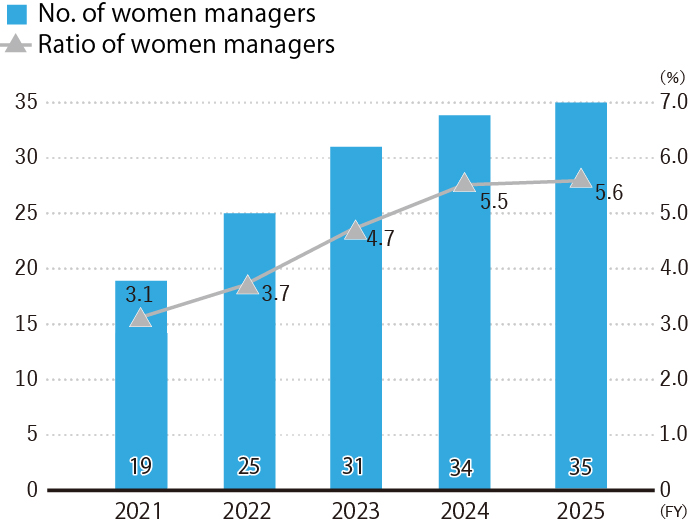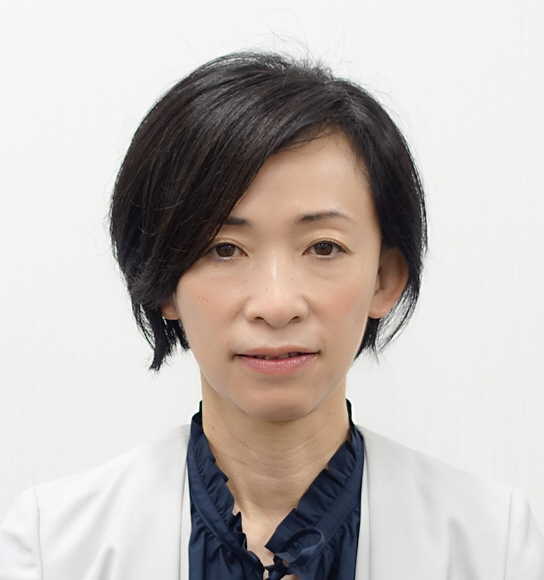Promotion of Women's Participation and Advancement
Progress so far, and the key issues
Promoting women's participation and advancement from the three perspectives of recruitment, cultivation, and support for employment continuation
As of 2015, our Group was predominantly male-oriented and did not provide adequate opportunities for women to thrive and grow. However, the Group began full-scale efforts to promote women’s participation and advancement in the workplace with the establishment of the Women Empowerment Promotion Group in 2015.
Under our Phase One Action Plan, spanning FY2017 to FY2021, we set goals to double the number of women in managerial positions compared to FY2016 and to raise the ratio of women in career-track positions*1 to 15%. We implemented a range of initiatives focused on three key areas: recruitment, development, and support for continued employment. As a result, by the end of FY2021, we had tripled the number of women in managerial roles to 13 and increased the ratio of women in career-track positions to 17.1%, thereby achieving our targets.
For our Phase Two Action Plan (April 1, 2021 - March 31, 2026), we set new goals: to raise the proportion of women in managerial positions to at least 5% and the ratio of women in career-track roles to at least 22%. We also set targets for at least 80% of eligible men employees to take paternity leave and to increase the average number of days taken for parental leave by 20% compared to FY2021. We have already exceeded both the women-in-management and men’s parental leave uptake targets ahead of schedule.
A significant factor behind the achievement of these goals was the establishment of a recruitment policy that set a target of 40% women among new graduate hires for the global career track*2. In parallel, we worked to broaden the scope of roles available to women by significantly increasing their placement in departments where women had previously not been assigned, such as sales and manufacturing. As a result, the promotion of women became a personal matter for many managers, driving a shift in mindset and contributing to a broader transformation of our organizational culture.
In addition to continuing these measures, our ongoing challenge is to establish equal opportunities and responsibilities without gender discrimination as the standard practice, eliminating the need for affirmative action. We believe that achieving our Phase Two Action Plan is crucial for this transition, emphasizing the importance of increasing employee awareness and sensitivity toward diversity issues.
- *1
- Defined as employees at or above the entry-level grade of the global career track.
- *2
- Career track for employees expected to play active roles across the entire organization.
Ratio of women Managers

Main measures implemented
- Women leader development seminars
- Diversity & inclusion training seminars for managers
- Career development support program
- Mentoring system
- Promoting notification to superiors and employees planning to take leave, and conducting pre- and post-leave interviews to encourage more employees to take leave
- Babysitter support system, including partial coverage of childcare costs during business trips
- Establishment of an on-site nursery at the Research Center, with a capacity for 10 children
- Introducing maternity workwear for women employees at business sites
Targets and action plans
In April 2021, we started our Phase Two Action Plan for promoting participation and advancement by women. We set numerical targets to be achieved by FY2026 including at least 5% ratio of women managerial staff*3. To meet these targets, we are advancing an initiative to increase the ratio of women among recent graduate hires on the global career track to 40%. In FY2025, our ratio of women managerial staff was 5.6% and the ratio of women among recent graduates hires on the global career track was 34%.
Toyobo also has a policy of participating actively in external initiatives. The company has already expressed its support for 30% by 2030 Challenge*5 goal announced by the Japan Business Federation (Keidanren) to raise the ratio of women executives to 30% by 2030, and for the Women's Empowerment Principles*6, which outline a code of conduct for actively promoting women empowerment; Toyobo has signed a statement committing itself to act in accordance with the WEPs.
Targets and Initiative Content
| 【Target No.1】Raise the share of managers who are women to at least 5% by the end of fiscal 2026 | |
|---|---|
| April 2021 onwards: |
Implement women leader cultivation training for managers and women candidates for managerial positions (continued implementation since August 2017) |
| April 2021 onwards: |
Implement women leader cultivation training for section chiefs and women candidates for section chief positions (continued implementation since September 2019) |
| April 2021 onwards: | Implement mid-career hiring of women managers |
| May 2022 onwards: | Launch diversity & inclusion training seminars for managers Aim to enhance communication with diverse employees |
| 【Target No.2】Raise the share of women on the career track to at least 22% by the end of fiscal 2026 | |
|---|---|
| April 2021 onwards: | Maintain women's share of new graduate recruitment at a level of at least 40% |
| April 2021 onwards: | Actively promote mid-career hiring of women employees |
| April 2021 onwards: | Implement follow-up interviews for women employees (continued implementation since April 2015) |
| April 2021 onwards: | Establishment and operation of a three-year career development support program |
| 【Target No.3】Raise the percentage of eligible men employees taking childcare leave to at least 80%, and increase the number of days of childcare leave taken by at least 20% by the end of fiscal 2026 | |
|---|---|
| April 2021 onwards: | Make eligible employees aware of the childcare leave system (continued implementation since April 2019) |
| April 2021 onwards: | Send eligible employees' supervisors details of the encouragement that should be provided to subordinates to encourage them to take childcare leave (continued implementation since September 2019) |
| October 2022 onwards: | To support trouble-free acquisition of leave and return to work, interviews between superiors and leave-takers before and after taking childcare leave are mandatory |
- *3
- Career track for employees who are expected to be active throughout the entire company.
- *4
- Career track for employees whose career is expected to be confined to one specific business site.
- *5
- This is one of the targets for promoting D&I to realize sustainable growth in line with “. The NEW Growth Strategy” announced by the Keidanren in November, 2020.
- *6
- The Women's Empowerment Principles were formulated jointly by UNGC and UN Women in 2010.
- *7
- Eruboshi (2-star) criteria: Must meet 3–4 of the specified criteria, and must demonstrate continued improvement for a period of at least two consecutive years.
Message from manager
The Group’s activities to promote women's participation and advancement in the workplace started in earnest with the launch of the Women Empowerment Promotion Group in 2015.
In 2023, the department name was changed to the Diversity & Inclusion Group. Its scope has expanded beyond promoting women's advancement to include initiatives for employees with disabilities, foreign nationals, sexual minorities, and efforts to create a workplace environment where all employees can work with peace of mind.
The steady efforts to promote women’s participation and advancement since 2015 have certainly led to an increase in the ratio of female managers and the uptake rate of childcare leave among men. These activities have also resulted in the creation of systems supporting diverse workstyles and brought about changes in the Company’s internal culture.
We will continue activities that support and encourage female employees, while gradually working toward creating a workplace where each employee can utilize their abilities without being conscious of their gender or other attributes.

Diversity & Inclusion Group Manager,
Labor Affairs Department
Masako Tezuka






